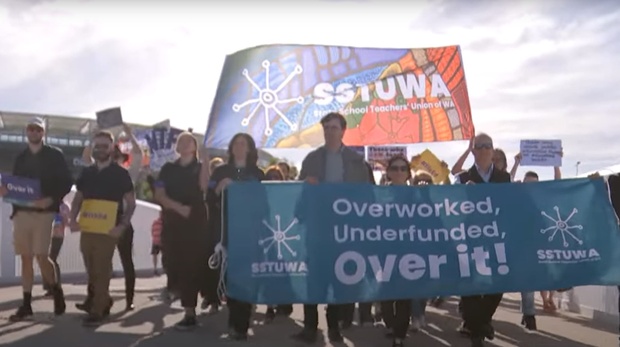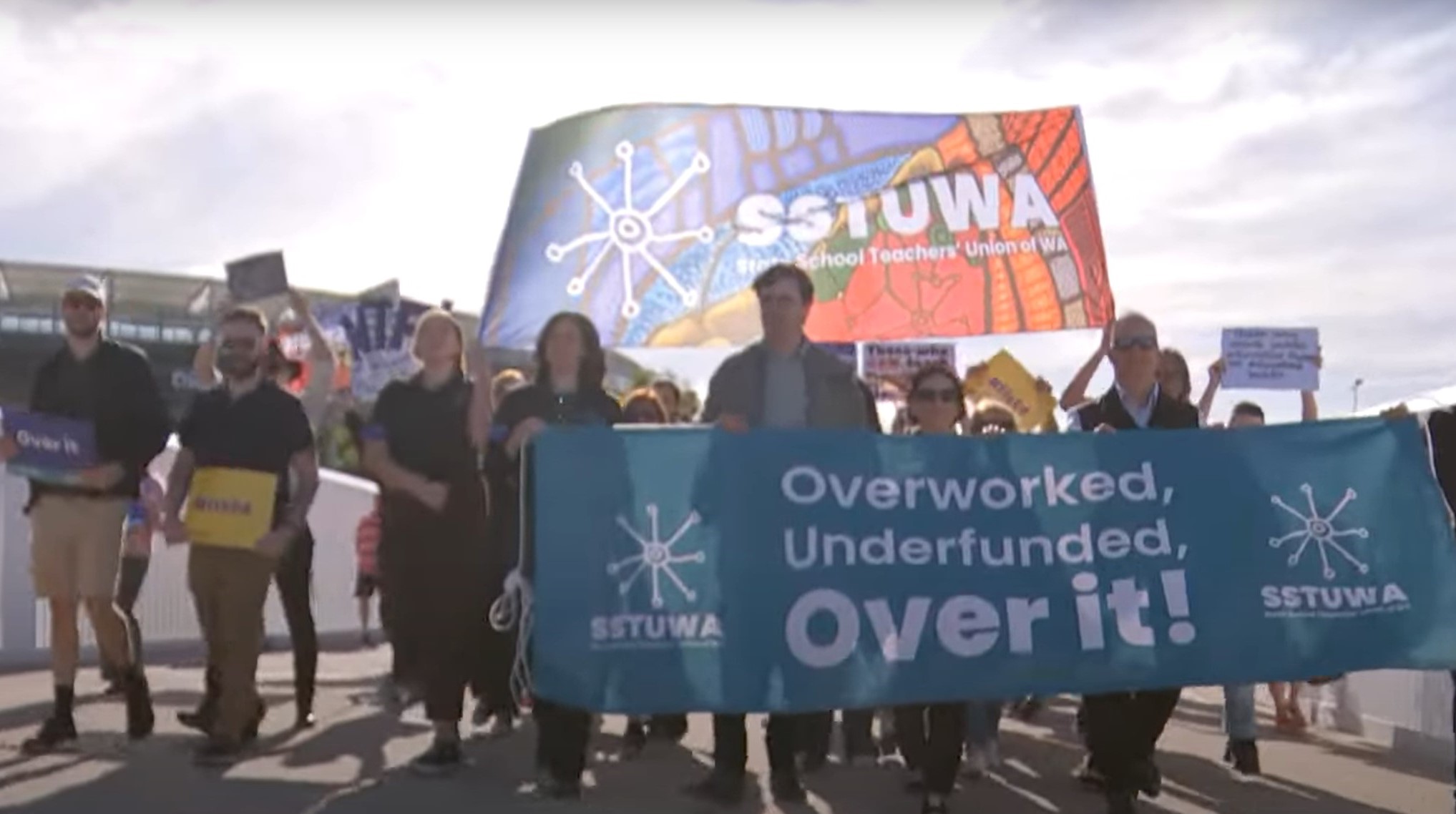Following negotiations with the State School Teachers’ Union of Western Australia (SSTUWA) and Principals’ Federation of Western Australia (PFWA), teachers and school leaders will receive a 12 per cent pay rise over three years and improvements to a range of conditions associated with leave, allowances and professional learning.
The SSTUWA ballot closed on Thursday, with more that 70 per cent of members voting in favour of accepting the Government’s offer.
The union had originally wanted a 7 per cent rise followed by a 5 per cent (or 12 per cent) rise over two years.
The deal came after months of back and forth between the union and the Government, which came to a head in April when thousands of teachers from more than 80 public schools across the state stopped work – the first time in 10 years that educators in WA had walked off the job over pay and conditions.
At the time, SSTUWA president Matt Jarman said that teachers and school leaders were overworked and underpaid and were already leaving the public education system in droves.
“If we want to attract and retain the best teachers in WA, they need to be paid adequately and have manageable workloads,” he said.
Industrial Relations Minister Simone McGurk said the agreement was good for teachers, schools and students.
“Delivering salary increases of 12 per cent over three years is a strong outcome, combined with measures to address workload, support teachers in the classroom and a range of other benefits,” she said in a statement.
Support for classroom teachers will also be strengthened with small group tuition in 350 schools focusing on literacy and numeracy, allowing students to develop these fundamental skills.
To help students facing unique challenges that require extra support, 64 new complex behaviour management coordinators will also be introduced.
These experts will work alongside classroom teachers to create tailored education programs to help students with disabilities and learning challenges, so every child receives the attention and resources they need to succeed.
The agreement also includes new district allowances to attract and retain more teachers in remote and regional areas. This includes incentive payments to develop leaders in regional areas and attract accomplished teachers to those schools with the greatest need.
Jarman said he hoped the agreement is registered with the Western Australian Industrial Relations Commission as soon as possible.
“[That would allow] for back pay and the claims and conditions to begin to flow to members,” he said in a statement on Thursday.
“Moving forward the SSTUWA will be engaging members and the broader public in a community campaign on the issue of class sizes.
“Whilst gains were made on the management of oversize classes through this agreement, the new measures must be monitored to assess their effectiveness as well as the extent of class size issues across the system.”
Education Minister Dr Tony Buti said the deal will see teachers, principals and school leaders paid appropriately, while cutting workload and boosting classroom resources.
“We value our teachers and are committed to enhancing the quality of education, ensuring that all students succeed,” Buti said.
“Teachers have such an important role in shaping the futures of young Western Australians, so it is vital that we recognise and reward this contribution while continuing to advance the profession.
“In addition to these commitments, work continues on a range of strategies to attract and retain quality teachers, support our workforce, and strengthen outcomes for students across Western Australia.”
Back in mid-April, Dr Saul Karnovsky from Curtin University’s School of Education told EducationHQ that teachers in the state had been pushed to the brink.
“We know that teachers, especially here in Western Australia, are saying that it’s not more pay that will keep them in the job, it’s about prioritising their health and wellbeing and their work/life balance,” he said.
“...it’s not just about the pay, it’s the conditions, and one of the most important of those is a reduction in class sizes."
Karnovsky said that in a SSTUWA survey from 2023, 86 per cent of teachers indicated that they intended, or considered, leaving the profession in the previous four years.
“Because if you’re already full throttle and you’ve already got one foot out the door, it doesn’t take much of a push to get both feet out the door...”
Ongoing consultation between the Government, the SSTUWA and PFWA will help to inform the design and implementation of new initiatives.
Summary of Benefits
Pay increase:
- 5.0 per cent per annum effective on and from 6 December 2023;
- 4.0 per cent per annum effective on and from 6 December 2024;
- 3.0 per cent per annum effective on and from 6 December 2025.
The Agreement will see a graduate teacher’s starting salary increase from $9781 to $88,178 and a senior teacher’s salary increase from $14,704 to $132,557.
Experienced Level 3 teachers will earn up to $147,077 and a senior school administrator up to $206,662.
Attraction and Retention
- Increasing the graduate allowance to give new teachers more financial support;
- Paid time for new starters to complete professional learning;
- Reclassification of several principal positions;
- Improvements to long service leave, personal leave and compassionate leave entitlements;
- The introduction of a district allowance for eligible employees;
- Additional travel concessions for staff in the Pilbara, Kimberley and Goldfields;
- Continuation of the extended air conditioning subsidy for eligible employees.
School Leader and Teacher Supports
- A new workload taskforce to support staff with workload management;
- Resources to support students who need it the most, including more staff to help with complex behaviour and run small group tuition focusing on literacy and numeracy;
- Helping classroom teachers meet the individual needs of students with disabilities and learning challenges.
Improved Career Pathways
- Creation of a new Senior Teacher Level 2 classification;
- Trial deployment of experienced teachers and school leaders to regional schools;
- Trial temporary deployment of exemplary teachers to newly created Level 3.3 positions in schools of most need.














